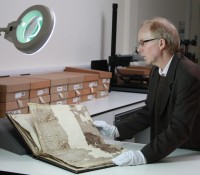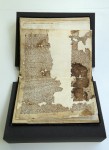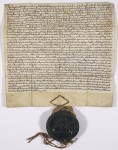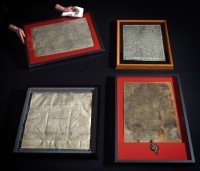 An exemplar of the 1300 edition of Magna Carta has been discovered in a Victorian-era scrapbook in the Kent History and Library Centre in Maidstone, Kent, southeast England. The newly discovered parchment is almost two feet long, but it is not in good condition. Moisture has claimed about a third of the document — a vertical strip down the middle is gone — and the royal seal of King Edward I is missing. Still, with so few exemplars surviving (there are only seven of the 1300 issue), even a damaged one is an exceptional find.
An exemplar of the 1300 edition of Magna Carta has been discovered in a Victorian-era scrapbook in the Kent History and Library Centre in Maidstone, Kent, southeast England. The newly discovered parchment is almost two feet long, but it is not in good condition. Moisture has claimed about a third of the document — a vertical strip down the middle is gone — and the royal seal of King Edward I is missing. Still, with so few exemplars surviving (there are only seven of the 1300 issue), even a damaged one is an exceptional find.
The document was discovered by Dr. Mark Bateson, Kent County Council’s community history officer, while he was looking for another medieval royal charter at the behest of University of East Anglia professor Nicholas Vincent, Principal Investigator for the Magna Carta Project, a wide-ranging study of the seminal charter limiting the rights of kings in anticipation of the 800th anniversary of its issue by King John at Runnymede on June 15th, 1215. Vincent asked Bateson to look up Sandwich’s original copy of the Charter of the Forest, a complementary charter to Magna Carta asserting public rights of access to royal forests first issued by John’s son King Henry III on November 6th, 1217. As the Kent History and Library Centre contains the county’s historic archives, a vast treasury of almost 9 miles of historical documents going back as far as 699 A.D., Bateson searched there for the Forest Charter.
 He found it pressed in a scrapbook put together by E. Salisbury, a British Museum official, in the late 19th century. This particular edition of the Charter of the Forest was issued to Sandwich in 1271. Turning the page, Bateson saw another medieval parchment and recognized it as Magna Carta. The 1300 issue date was still visible at the bottom of the page. Professor Vincent authenticated it as genuine from its layout, the handwriting of the scribe and the details of the text which match the other surviving 1300 Magna Cartas.
He found it pressed in a scrapbook put together by E. Salisbury, a British Museum official, in the late 19th century. This particular edition of the Charter of the Forest was issued to Sandwich in 1271. Turning the page, Bateson saw another medieval parchment and recognized it as Magna Carta. The 1300 issue date was still visible at the bottom of the page. Professor Vincent authenticated it as genuine from its layout, the handwriting of the scribe and the details of the text which match the other surviving 1300 Magna Cartas.
Since King John was made to sign the first issue by his rebellious barons in 1215, Magna Carta was reissued multiple times to affirm and modify the enumerated rights. The 1300 reissue was the last to be distributed under the king’s seal, and the fact that Sandwich received a copy may indicate Magna Carta was more widely distributed to smaller towns and ports than previously thought. Sandwich was one of the Cinque Ports, a confederation of five coastal towns who maintained fleets of ships for the monarch in return for tax breaks and a number of self-government rights. Richard the Lionheart landed in Sandwich in 1194 upon his return to England after the extortionate ransom demanded by his captor, Henry VI, Holy Roman Emperor, was paid. The only other Cinque Ports town known to have a copy of Magna Carta is Faversham. Professor Vincent hopes the discovery of the Sandwich Magna Carta may be an indication that other small towns could have one of their own squirreled away in their archives.
 The fact that Sandwich has originals of both the 1300 Magna Carta and the Charter of the Forest in its archives is exceptionally rare. Only one other institution, Oriel College, Oxford, has the same pair. The two go together like the proverbial horse and carriage, historically speaking. The Charter of the Forest was issued to expand upon the forest law references in Magna Carta, like a Forest Bill of Rights to Magna Carta’s Constitution. Since avid hunter William the Conqueror first established a separate forest law to keep people from messing with his personal game preserve, lands declared royal forest had expanded greatly, especially under King Richard and King John. The Plantagenet kings had claimed ever more land, some of it not even wooded but rather moor or pasture land or even villages, as royal forest and forbade traditional customs like the use of forests as common land for grazing, fishing, collecting firewood, foraging or cultivating subsistence crops. The Charter of the Forest restored these rights to free men and abolished the death penalty for taking the king’s venison. Magna Carta deals with the rights of barons, so the Forest Charter is actually the first charter to protect the rights of the regular people from aristocratic overreach.
The fact that Sandwich has originals of both the 1300 Magna Carta and the Charter of the Forest in its archives is exceptionally rare. Only one other institution, Oriel College, Oxford, has the same pair. The two go together like the proverbial horse and carriage, historically speaking. The Charter of the Forest was issued to expand upon the forest law references in Magna Carta, like a Forest Bill of Rights to Magna Carta’s Constitution. Since avid hunter William the Conqueror first established a separate forest law to keep people from messing with his personal game preserve, lands declared royal forest had expanded greatly, especially under King Richard and King John. The Plantagenet kings had claimed ever more land, some of it not even wooded but rather moor or pasture land or even villages, as royal forest and forbade traditional customs like the use of forests as common land for grazing, fishing, collecting firewood, foraging or cultivating subsistence crops. The Charter of the Forest restored these rights to free men and abolished the death penalty for taking the king’s venison. Magna Carta deals with the rights of barons, so the Forest Charter is actually the first charter to protect the rights of the regular people from aristocratic overreach.
 The Charter of the Forest also bears the honor of being the cause for the coining of the epic name “Magna Carta.” The term was first used in a 1218 proclamation to distinguish the “Great Charter” from its smaller and more focused relation, the Forest Charter. In 1297, Edward I issued the two charters together in the Confirmatio Cartarum, or Confirmation of Charters, to pacify yet more unruly barons who were mad at him for taxing them. It’s of note that Sandwich received both charters even though the county of Kent had no royal forest. It suggests the two went out together as a team no matter the destination.
The Charter of the Forest also bears the honor of being the cause for the coining of the epic name “Magna Carta.” The term was first used in a 1218 proclamation to distinguish the “Great Charter” from its smaller and more focused relation, the Forest Charter. In 1297, Edward I issued the two charters together in the Confirmatio Cartarum, or Confirmation of Charters, to pacify yet more unruly barons who were mad at him for taxing them. It’s of note that Sandwich received both charters even though the county of Kent had no royal forest. It suggests the two went out together as a team no matter the destination.
 This is obviously a banner year for Magna Carta enthusiasts. Last week, the four surviving exemplars of the 1215 Magna Carta came together for the first time in a “unification” exhibition at the British Library. As these are very delicate documents, there was limited space for people to visit the once-in-a-millennium event so the BL went fully democratic and randomly selected 1,215 attendees from 43,715 applications received from more than 20 countries. After the all too brief three days of unification, the two Magna Cartas that do not live at the British Library permanently returned to their home bases: Salisbury Cathedral and Lincoln Cathedral. Salisbury Cathedral will host an exhibition of its own starting on March 6th. Lincoln Cathedral’s Magna Carta will be on display in a fancy new vault built at Lincoln Castle starting April 1st.
This is obviously a banner year for Magna Carta enthusiasts. Last week, the four surviving exemplars of the 1215 Magna Carta came together for the first time in a “unification” exhibition at the British Library. As these are very delicate documents, there was limited space for people to visit the once-in-a-millennium event so the BL went fully democratic and randomly selected 1,215 attendees from 43,715 applications received from more than 20 countries. After the all too brief three days of unification, the two Magna Cartas that do not live at the British Library permanently returned to their home bases: Salisbury Cathedral and Lincoln Cathedral. Salisbury Cathedral will host an exhibition of its own starting on March 6th. Lincoln Cathedral’s Magna Carta will be on display in a fancy new vault built at Lincoln Castle starting April 1st.
The British Library’s upcoming Magna Carta exhibition runs March 13th through September 1st, 2015. It is sponsored by legal firm Linklaters which has set up a simple and effective Magna Carta viewer where you can zoom in on a legible exemplar and read a transcript or translation of it.